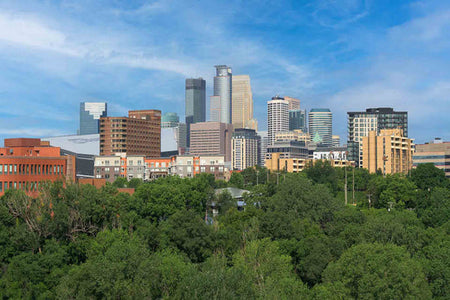- Arizona's allergy season runs from early spring to late fall, with tree, grass, and weed pollen affecting different times of the year.
- Proactive steps, like using a HEPA vacuum, wearing sunglasses and masks, and keeping windows closed, help reduce exposure to allergens.
- Allermi offers a tailored nasal spray to manage multiple allergy symptoms in one treatment.
Arizona has a mix of desert areas and high mountains, which creates a variety of plants that thrive in its warm climate. While the sunny weather draws many people outside, it also means that allergy sufferers need to be on guard.
Different plants in Arizona release pollen at various times throughout the year, so it’s important for residents and travelers to know when allergy season starts.
This awareness can help everyone get ready for symptoms that could disrupt their daily activities and enjoyment of Arizona's beautiful sights.
When is the Pollen Season in Arizona?
Pollen season in Arizona varies by region and plant type, but generally, it spans from early spring to late fall.
In central and southern Arizona, tree pollen is most prevalent from February to April. Key contributors include juniper (cedar) and pine trees which are highly allergenic [*].
Grass pollen typically peaks in late spring and early summer, particularly during May and June. On the other hand, weeds, especially ragweed, can cause significant issues from late summer through fall, and peak in September and October.
Northern Arizona experiences a similar pattern but with slight variations in timing due to its different climate and elevation. Tree pollen generally follows a similar timeline, while grass and weed pollens might peak slightly later or earlier depending on local conditions.
Residents and visitors need to monitor local pollen forecasts during these months to manage allergy symptoms effectively.
What are the Worst Months for Allergies in Arizona?
The worst months for allergies in Arizona vary slightly by region within Arizona, but generally, these are the times when allergy sufferers experience the most discomfort:
- February to April. Tree pollen, especially from juniper and pine, is at its peak during this period, leading to significant allergy symptoms.
- May and June. Grass pollen becomes prominent in late spring and early summer, affecting many individuals.
- September and October. Ragweed pollen is a major trigger during the fall, causing increased allergy issues as this weed releases its pollen.
When Does Pollen Season End in Arizona?
Pollen season in Arizona generally begins to taper off in late fall, typically around November. By this time, the peak pollen from trees, grasses, and weeds has subsided, leading to lower pollen counts. However, the exact timing can vary by region and specific plant types.
In southern Arizona, for example, weed pollen, particularly from ragweed, can linger until the first frost, which often occurs in late November or early December. In northern Arizona, the cooler temperatures can lead to an earlier end to the pollen season.
Overall, while most pollen activity declines in November, some allergens may still be present depending on the local climate and weather conditions.
Common Allergens in Arizona
Arizona's unique climate contributes to a year-round growing season, which means that various plants release pollen at different times throughout the year.
Here are some of the most common allergens in Arizona:
- Juniper
- Pine
- Cottonwood
- Bermuda
- Ryegrass
- Ragweed
- Mold (can thrive despite the generally dry climate)
- Dust mites (found indoors and are common all year round)
How to Prepare for Seasonal Allergies in Arizona
Getting ready for seasonal allergies in Arizona means taking steps to reduce exposure to allergens and manage symptoms. This includes simple actions like limiting time outdoors when pollen levels are high and taking medications to help control symptoms.
Follow these preparation tips:
- Check local pollen forecasts regularly to stay informed about allergy levels and plan outdoor activities accordingly. Websites and apps that provide daily pollen counts can help you prepare for high pollen days.
- Begin taking allergy medications, such as antihistamines or nasal sprays, before peak pollen seasons to minimize symptoms. One notable option is Allermi, a customized nasal spray designed to address multiple allergy symptoms (such as sneezing, itching, nasal congestion, and runny nose) in one convenient solution.
- Even when outdoor pollen levels are high, indoor air can still be compromised if windows and doors are left open. During high pollen days, keep windows closed in your home and car to prevent pollen from entering.
- Use HEPA air purifiers to help filter out allergens and improve indoor air quality. For comprehensive protection, homeowners may consider whole-home air purification systems that integrate HEPA filters into their HVAC systems.
- After spending time outdoors, it’s a good idea to shower and change your clothes. Pollen can easily stick to your skin, hair, and clothing, and if left on, it can continue to trigger allergy symptoms even when you're indoors.
- Try to stay indoors during peak pollen times, typically in the early morning and late afternoon. This can help you avoid these triggers and feel more comfortable during allergy season in Arizona.
- Use sunglasses and masks when going outdoors to protect your eyes and respiratory system from allergens. Sunglasses shield your eyes from pollen that can cause itching and irritation, while a mask helps filter the air you breathe to reduce the amount of pollen and dust you inhale.
- Dust and vacuum your home frequently using a vacuum with a HEPA filter to reduce indoor allergens. Pollen, pet dander, and dust mites can easily get inside and settle on furniture and floors. A vacuum with a HEPA filter is helpful because it traps tiny particles, keeping them from going back into the air.
The Bottom Line
Allergy season in Arizona can be tough, but with the right steps, you can reduce its effects on your daily life. One of the best ways to manage symptoms is by using a combination nasal spray like Allermi. Starting treatment early, along with other preventive measures, can make allergy season much more manageable.
References:
- Cedar Fever. (2024, May 1). Cleveland Clinic. https://my.clevelandclinic.org/health/diseases/25120-cedar-fever
- Chen, C., Hsu, C., Chang, Y., Lee, C., & Lee, D. L. (2021). Efficacy of HEPA Air Cleaner on Improving Indoor Particulate Matter 2.5 Concentration. International Journal of Environmental Research and Public Health, 19(18), 11517. https://doi.org/10.3390/ijerph191811517









